|
|||||||||
|
FEATURESDuanwu: The Sino-Korean Dragon Boat Races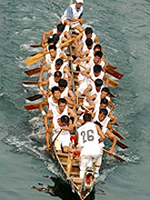 Fig.1 Dragon boat racing team in action. Source: winkai.blog.gtvod.com. In November 2005, UNESCO inscribed the Dano-je Festival of the Korean town of Gangneung as an intangible cultural heritage property of mankind. (Figs.2&3) Celebrated for at least five days to either side of the 5th day of the 5th month of the traditional Korean lunar calendar, Dano is regarded as the time of year when the male element of nature is at its most powerful. Dano is one of the four main national or 'public' holidays in Korea, the others being New Year's Day, Hansik and Chuseok. The celebration of Dano in the coastal town of Gangneung, located in South Korea's Gangwon prefecture, is especially distinctive, being accompanied by masques and shamanist ritual performances, and it has a history of at least one thousand years, although it only acquired the outline of its present day form during the last century. Within Korea itself, the Dano celebrations of Gangneung were listed as early as 1967 as the thirteenth indigenous cultural item to be classified as 'a major intangible cultural asset of the ROK', and since that time, and over the past decade in particular, tourism has been promoted and developed vigorously in and around Gangneung. The successful Korean nomination was prompted by pride in the cultural uniqueness of the festivities and celebrations in Gangneung within an international context, and it was backed up by the thorough documentation of the Gangneung Dano-je presented to UNESCO. 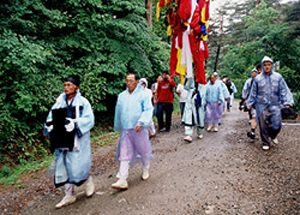 Fig.2 Scene from the Gangneung Danoje festival in South Korea. 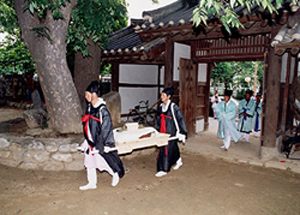 Fig.3 Scene from the Gangneung Danoje festival in South Korea. However, news of the nomination in early 2005 created a furore in China, and the later successful listing by UNESCO resulted in Chinese accusations that the listing was an international endorsement of the brazen appropriation by the Koreans of a Chinese intangible heritage property. Chinese vitriol flowed on the web in equal measure to that of Korean bloggers who had earlier accused the Chinese of hijacking the patrimony of the ancient Korean kingdom and culture of Gaogouli (Koguryo). Many Chinese bloggers argued that Korea had been slowly encroaching on China's cultural heritage since the discovery of the world's oldest printed texts more than a decade previously and some Chinese commentators also accused Korean cultural heritage officials of preparing to apply for the listing of 'Chinese traditional medicine' as 'Korean traditional medicine'. The Dano festival is the Korean equivalent of the Duanwu Festival, better known internationally as the Dragon Boat Festival,(Fig.4) which is celebrated on the 5th day of the 5th month of the Chinese lunar calendar. The Duanwu Festival is celebrated throughout East Asia, from Mongolia to Singapore. While Duanwu is known in Korean as Dano, in Japanese it is called Tango and in Vietnamese, Tet Doan Ngo.  Fig.4 Dragon boat racing team in action. Source: winkai.blog.gtvod.com. The similar names by which this festival is known throughout East Asia make it clear that the nomenclature and the original codification of this event and festival did indeed originate in China. (Duanwu was one of the three major traditional festivals of the Chinese lunar calendar, the others being Chinese New Year and the other being the Mid-Autumn Festival. Of these traditional festivals, only Chinese New Year is a national holiday in the People's Republic of China, and Duanwu was largely neglected in the PRC after 1949, even though it continued to be celebrated in Chinese communities outside the mainland.) However, the content of the various other 'Duanwu'festivals in East Asia tends to be distinctively local and the festival varies dramatically from country to country. In the face of Chinese outrage, UNESCO and Korean heritage officials were quick to point out that it was a specific local variation of the Dano festival – as celebrated with shamanistic accompanying rituals in Gangneung – that had been listed. The upshot of UNESCO's listing of this Korean festival saw Chinese cultural heritage officials rush to list all Chinese traditional festivals as well as all their various local variations as 'intangible cultural heritage items'. However, Korean cultural heritage officials had never denied the Chinese origins of the Duanwu festival, although the festival, once introduced to Korea, developed along its own lines for the subsequent millennium and more. The celebrations accompanying the Dano festival in Gangneung can extend for as long as a month, and in Korea the festival praises the mountain deity and male and female tutelary deities through a shamanistic ritual that includes the brewing of sacred liquor on Daegwallyeong Ridge that stands outside the city of Gangneung. The Korean festival also encompasses a number of local folk performance forms, including Odokddegi folk songs, Gwanno masked dramas and oral narrative poetry, as well as various popular pastimes, including the Korean seesaw-trapeze that combines ingredients of the autochthonous seesaw and maypole pastimes and the game of 'tossing the arrow' that derived from ancient China. Korea's largest outdoor handicrafts market is also staged during the festival in Gangneung, and this is a showcase for the work of traditional Korean artisans. In China, the origins of the Duanwu Festival were associated with the ancient kingdom of Chu. What is striking about Gangneung (Chinese: Jiangling) in Gangwon-do prefecture is that the isolated area in which it is located on the eastern coast of Korea has a number of place names borrowed from ancient Chu. Here can be found local renderings of localities in Hunan province, China, such as Dongting Lake (Dungjungchuwal), all associated part of the Duanwu mythology. Ancient Chu and the Gangwon region in Korea both have rich traditions of shamanism, and some scholars in China have even argued that Gangwon shamanism came from Chu-Miao traditions, but it would seem to be safer to speak of shamanistic affinities. [1] However, almost all histories of Korean shamanism attribute its origins among various Tungusic peoples of north-eastern Asia. The listing of the Korean variant of the Duanwu festival had the salutary effect of prompting Chinese scholars and folklorists to look more closely at their own much neglected festival traditions. The examination of folklore had accompanied the beginnings of modern nationalism in China in the early decades of the 20th century, and even earlier during the closing years of the Qing dynasty (1644-1911). In the 1920s and 1930s several Chinese scholars of literature and poetry, including Wen Yiduo (1899-1946), Zheng Zhenduo (1898-1958) and Guo Moruo (1892-1978), focused folkloric attention on the Duanwu festival and its origins, and their efforts shed light on the connection between vernacular literary, ethnic and folkloric traditions. The Duanwu festival through its associations with the ancient poet Qu Yuan (c. 340-278 BCE) was regarded by them as part of an alternative vernacular Chinese history.(Fig.5)  Fig.5 Seven metre high statue of Qu Yuan at the Qu Yuan Memorial Hall in Zigui, Hubei, the hometown of Qu Yuan. In the 20th century Qu Yuan came to be regarded as the ancient poet who first articulated the personal voice of 'the people'. Of the many theories concerning the origins of the Duanwu festival that have been proposed by scholars and historians over the past century, the most popular theory insists that the festival celebrated the patriotic self-sacrifice of Qu Yuan, who was both poet and official during the Warring States period in the service of the king of Chu. Qu Yuan, whose role was akin to that of a state oracle and who participated through his rhapsodic verses in the religious mysteries of that state, was depicted by ancient Confucian scholars and by 20th century patriots and nationalists alike as a seer who foresaw the dire political fate that awaited his state and fought for the survival of his nation. The profligate monarch who was Qu Yuan's overlord did not heed the poet's warnings regarding the betrayal that awaited Chu at the hands of the ostensible ally Qin, and for his warnings Qu Yuan found himself unappreciatively expelled from the court and sent into exile. Eventually the state of Chu was vanquished by the armies of Qin. In despair at failing to save his homeland from the enemy, Qu Yuan threw himself into the Miluo River near today's Yueyang in Hunan province. The 'dragon boat racing' held in conjunction with the Duanwu Festival was later interpreted as a re-enactment of the search for the drowning poet and the event was staged in memory of this man of noble spirit. The custom of preparing zongzi, glutinous rice buns wrapped in lotus leaves eaten at this time of year, was also linked to the Qu Yuan legend.(Fig.6) 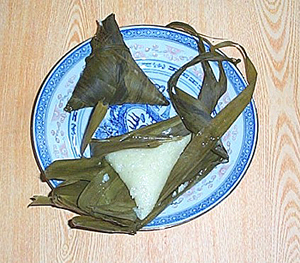 Fig.6 Illustration of typical zongzi with wrapping. In 1941, following the Japanese occupation of much of China, Qu Yuan was invoked as a patriotic hero opposed to foreign domination and the Duanwu Festival was celebrated among progressive circles led by Guo Moruo and other influential left-wing writers as 'Poets' Day'. After 1949, Qu Yuan was depicted as both a patriot and as a man of conscience, but this 'dissident' Qu Yuan was little referred to after the early 1960s.[3] Although people continued to make and eat zongzi at Duanwu, the related customs of the festival fell into decline in the PRC. The revival in China of many traditions that began in the 1980s focused on the revival of 'dragon boat'. In 1988 the central government designated 'dragon boat' racing as an official sporting event, and since then there have been exchanges with teams of rowers from many South-east Asian and Western countries. 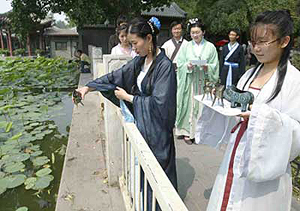 Fig.7 Feeding fishes in Beijing's Houhai during a re-enactment of Duanwu on 16 June 2007. The Dano-je festival of Gangneung is no more related to the vestigial Duanwu celebrations in the PRC than, for example, the 19th century celebrations of Noël in France are related to today's celebrations of Christmas in the USA. The listing of the Korean festival by UNESCO was, however, a rude awakening for China's cultural heritage officials and the Korean case provided a blueprint for Chinese officials in determining how a country goes about having its intangible cultural heritage properties listed. Notes:[1] Ref: Yang Wanjuan, 'A preliminary study of the sources of Korean culture and Chinese Chu culture' (Hanguo wenhua yu Zhongguo Chu wenhua yuanyuan chutan), Zhongnan Minzu Daxue xuebao (Journal of South-Central Nationalities University), 2005:1, pp 10-14. [2] David Hawkes tr., The Songs of the South: An Ancient Chinese Anthology of Poems by Qu Yuan and Other Poets, London: Penguin, 1985. Gladys Yang and Yang Xianyi tr., Li Sao and Other Poems of Qu Yuan, Beijing: Foreign Languages Press, 2001 reprint. [3] Laurence Schneider, A Madamn of Ch'u: The Chinese myth of Loyalty and Dissent, Berkeley: University of California press, 1980. |